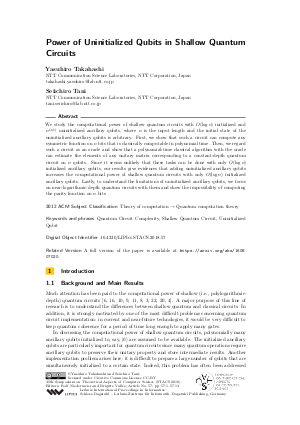Power of Uninitialized Qubits in Shallow Quantum Circuits
Authors Yasuhiro Takahashi, Seiichiro Tani
-
Part of:
Volume:
35th Symposium on Theoretical Aspects of Computer Science (STACS 2018)
Part of: Series: Leibniz International Proceedings in Informatics (LIPIcs)
Part of: Conference: Symposium on Theoretical Aspects of Computer Science (STACS) - License:
 Creative Commons Attribution 3.0 Unported license
Creative Commons Attribution 3.0 Unported license
- Publication Date: 2018-02-27
File

PDF
LIPIcs.STACS.2018.57.pdf
- Filesize: 0.64 MB
- 13 pages
Document Identifiers
Subject Classification
Keywords
- quantum circuit complexity
- shallow quantum circuit
- uninitialized qubit
Metrics
- Access Statistics
-
Total Accesses (updated on a weekly basis)
0Document
0Metadata
Abstract
We study the computational power of shallow quantum circuits
with O(log n) initialized and n^{O(1)} uninitialized ancillary
qubits, where n is the input length and the initial state of
the uninitialized ancillary qubits is arbitrary. First, we show
that such a circuit can compute any symmetric function on n bits
that is classically computable in polynomial time. Then, we
regard such a circuit as an oracle and show that a
polynomial-time classical algorithm with the oracle can estimate
the elements of any unitary matrix corresponding to a
constant-depth quantum circuit on n qubits. Since it seems unlikely
that these tasks can be done with only O(log n) initialized
ancillary qubits, our results give evidences that adding
uninitialized ancillary qubits increases the computational power
of shallow quantum circuits with only O(log n) initialized
ancillary qubits. Lastly, to understand the limitations of
uninitialized ancillary qubits, we focus on
near-logarithmic-depth quantum circuits with them and show
the impossibility of computing the parity function on n bits.
Cite As Get BibTex
Yasuhiro Takahashi and Seiichiro Tani. Power of Uninitialized Qubits in Shallow Quantum Circuits. In 35th Symposium on Theoretical Aspects of Computer Science (STACS 2018). Leibniz International Proceedings in Informatics (LIPIcs), Volume 96, pp. 57:1-57:13, Schloss Dagstuhl – Leibniz-Zentrum für Informatik (2018)
https://doi.org/10.4230/LIPIcs.STACS.2018.57
BibTex
@InProceedings{takahashi_et_al:LIPIcs.STACS.2018.57,
author = {Takahashi, Yasuhiro and Tani, Seiichiro},
title = {{Power of Uninitialized Qubits in Shallow Quantum Circuits}},
booktitle = {35th Symposium on Theoretical Aspects of Computer Science (STACS 2018)},
pages = {57:1--57:13},
series = {Leibniz International Proceedings in Informatics (LIPIcs)},
ISBN = {978-3-95977-062-0},
ISSN = {1868-8969},
year = {2018},
volume = {96},
editor = {Niedermeier, Rolf and Vall\'{e}e, Brigitte},
publisher = {Schloss Dagstuhl -- Leibniz-Zentrum f{\"u}r Informatik},
address = {Dagstuhl, Germany},
URL = {https://drops.dagstuhl.de/entities/document/10.4230/LIPIcs.STACS.2018.57},
URN = {urn:nbn:de:0030-drops-84907},
doi = {10.4230/LIPIcs.STACS.2018.57},
annote = {Keywords: quantum circuit complexity, shallow quantum circuit, uninitialized qubit}
}
Author Details
References
-
A. Barenco, C. H. Bennett, R. Cleve, D. P. DiVincenzo, N. Margolus, P. Shor, T. Sleator, J. A. Smolin, and H. Weinfurter. Elementary gates for quantum computation. Physical Review A, 52(5):3457-3467, 1995.

-
D. Bera. Quantum circuits: power and limitations. PhD thesis, Boston University, 2010.

-
D. Bera. A lower bound method for quantum circuits. Information Processing Letters, 111(15):723-726, 2011.

-
S. Bravyi, D. Gosset, and R. König. Quantum advantage with shallow circuits, 2017. arXiv:1704.00690.

-
H. Buhrman, R. Cleve, M. Koucký, B. Loff, and F. Speelman. Computing with a full memory: catalytic space. In Proceedings of the 46th ACM Symposium on Theory of Computing (STOC), pages 857-866, 2014.

-
R. Cleve and J. Watrous. Fast parallel circuits for the quantum Fourier transform. In Proceedings of the 41st IEEE Symposium on Foundations of Computer Science (FOCS), pages 526-536, 2000.

-
D. P. DiVincenzo. The physical implementation of quantum computation. Fortschritte der Physik, 48(9-11):771-783, 2000.

-
M. Fang, S. Fenner, F. Green, S. Homer, and Y. Zhang. Quantum lower bounds for fanout. Quantum Information and Computation, 6(1):46-57, 2006.

-
S. Fenner, F. Green, S. Homer, and Y. Zhang. Bounds on the power of constant-depth quantum circuits. In Proceedings of Fundamentals of Computation Theory (FCT), volume 3623 of Lecture Notes in Computer Science, pages 44-55, 2005.

-
F. Green, S. Homer, C. Moore, and C. Pollett. Counting, fanout, and the complexity of quantum ACC. Quantum Information and Computation, 2(1):35-65, 2002.

-
P. Høyer and R. Špalek. Quantum fan-out is powerful. Theory of Computing, 1(5):81-103, 2005.

-
S. Jukna. Boolean Function Complexity: Advances and Frontiers. Springer, 2012.

-
E. Knill and R. Laflamme. Power of one bit of quantum information. Physical Review Letters, 81(25):5672-5675, 1998.

-
T. D. Ladd, F. Jelezko, R. Laflamme, Y. Nakamura, C. Monroe, and J. L. O'Brien. Quantum computing. Nature, 464:45-53, 2010.

-
G. De las Cuevas, W. Dür, M. van den Nest, and M. A. Martin-Delgado. Quantum algorithms for classical lattice models. New Journal of Physics, 13(093021), 2011.

-
C. Moore and M. Nilsson. Parallel quantum computation and quantum codes. SIAM Journal on Computing, 31(3):799-815, 2001.

-
X. Ni and M. van den Nest. Commuting quantum circuits: efficient classical simulations versus hardness results. Quantum Information and Computation, 13(1&2):54-72, 2013.

-
M. A. Nielsen and I. L. Chuang. Quantum Computation and Quantum Information. Cambridge University Press, 2000.

-
Y. Takahashi and N. Kunihiro. A quantum circuit for Shor’s factoring algorithm using 2n+2 qubits. Quantum Information and Computation, 6(2):184-192, 2006.

-
Y. Takahashi and S. Tani. Collapse of the hierarchy of constant-depth exact quantum circuits. Computational Complexity, 25(4):849-881, 2016.

-
Y. Takahashi and S. Tani. Power of uninitialized qubits in shallow quantum circuits, 2017. arXiv:1608.07020v3.

-
Y. Takahashi, T. Yamazaki, and K. Tanaka. Hardness of classically simulating quantum circuits with unbounded Toffoli and fan-out gates. Quantum Information and Computation, 14(13&14):1149-1164, 2014.

-
J. Watrous. On the complexity of simulating space-bounded quantum computations. Computational Complexity, 12(1-2):48-84, 2003.

